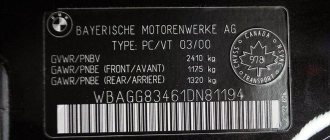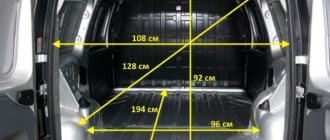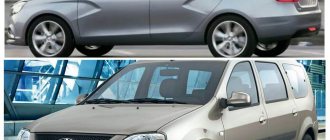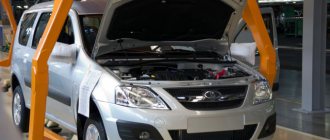Car : Lada Largus. Asks : Alexander Ushakov. Question : does the Lada Largus have a galvanized body or not?
On my Largus station wagon, after the fender was scratched, the metal began to bloom for some reason. Rust appeared near the chip site. Isn't the body of the Lada Largus galvanized?
In different brochures they write one thing: all external panels are protected with zinc! It seems like it can’t even be any other way. But I couldn’t detect zinc on the metal where there was a scratch. What does it mean? I just want to find out who is deceiving whom.
Everything that is clear about galvanizing the body of Lada cars: Vesta, Granta, X Ray and Largus
Ladas have not yet caught up with foreign cars in protecting the body from corrosion, but they are moving in this direction.
A zinc-coated body means coating it with scrap zinc, which provides additional protection against corrosion. Thus, the better the body is galvanized, the longer rust will not appear on it. But is it necessary to create additional body anti-corrosion treatment on a Lada car or do modern models not need this?
For those who don’t want to read a lot: The frets are galvanized using the cheapest technology, which is why they rust a little better than foreign cars.
Galvanizing methods used by automakers vary. The higher the galvanization properties of the body, the higher the cost of the car will be, and you can save noticeably by using the least reliable protection.
A more reliable method is hot-dip galvanizing - the alloy is coated with a layer of zinc when the body is immersed in a special bath filled with molten zinc. This method is used by large manufacturers.
AvtoVAZ uses cataphoresis-type priming, when the “preliminary” body is dipped into a bath containing a special primer. In this case, the surface of the body is covered with a phosphate film, which acts as protection against corrosion. The durability of the body is specifically affected by the properties of this layer.
In addition, at AvtoVAZ, body parts are protected by cool galvanizing: a composition with zinc powder is applied to the surface. The process is somewhat reminiscent of painting.
Advantages
The power part of the car is characterized by a long service life, amounting to hundreds of thousands of kilometers. In this case, the weak link is the body.
After only 2-3 years of operation, rust appears on it, which requires urgent repairs and subsequent touch-up of problem areas.
To extend the life of metal, car manufacturers and car enthusiasts resort to galvanizing the metal, which provides the following effect:
- Resistant chemical protection from external influences;
- Resistant to moisture and chemicals. Coating the metal base with zinc guarantees reliable protection of the body and gives the car enthusiast a chance to forget about the problems of operation.
On the other hand, it is worth highlighting a number of disadvantages:
- Full galvanization is a minus from an environmental point of view. Scientists have proven that such coatings are harmful and affect the state of the atmosphere and human health;
- Galvanized body elements are prohibited from sanding or cleaning. Otherwise, the treated area will instantly become covered with a layer of rust.
There are situations when paint comes off from galvanizing. This requires the involvement of craftsmen who will remove the necessary layer and properly treat the surface.
Recently, there has been a widespread myth that galvanized metal does not rust at all. This is wrong.
In practice, galvanizing inhibits corrosion, but without additional coating with an anti-corrosion compound, even a layer of zinc is not a guarantee of salvation.
Few people know, but the zinc layer is a couple of microns, which does not protect the body part from chemicals.
The zinc “shield” of any car, be it a Lada Vesta, Ford Focus, Opel or Renault (Logan, Sandero, Duster), decreases over time.
Mechanical damage, such as a stone impact, accelerates the corrosion process. But that's not all.
During operation, the metal is subjected to vibrations and shocks, which leads to the appearance of microcracks and dents, which act as an aid to the onset of corrosion.
We must not forget that galvanizing is different from galvanizing. Here it is worth highlighting the following options - full or partial, one-sided or two-sided.
At the same time, the methods for applying the protective layer also differ (more on this below).
In addition, each car has a group of hidden elements - pillars, side members, boxes and sills, where rust first appears.
So the treatment is good only in combination with additional treatment with an anti-corrosion compound.
Lada models with zinc-coated body
There is no clear information about how many parts are galvanized and AvtoVAZ does not disclose them. Various characteristics are named, but there is no official confirmation of them. According to media data (Mass media, mass media - periodicals, radio, television and video programs)
, Lada cars have the following degree of galvanization:
- VAZ-2110: 30%;
- Niva 2131/2121, Lada 4x4: no zinc-coated steel, cataphoretic priming;
- Kalina (1st generation): 52%;
- Kalina (2nd generation): fully galvanized, not counting the hood, roof, rear/front side members;
- Priora: models from 08.2008 – galvanized 29%, from 2009 – 100%;
- Largus: there are zinc-coated parts, which ones are unknown;
- Vesta: the outer layer of the body is one hundred percent galvanized (sedan - with a non-galvanized roof, station wagon - fully galvanized), the bottom and sills have anti-gravel protection;
- Xray: External body elements are one hundred percent galvanized, except for the roof.
And now what is officially clear:
- Granta (sedan): zinc-coated steel makes up 32% of the weight of all body parts. The proportion of hot-dip galvanized steel with both sides coated from zinc-coated alloy is 75%. The bottom is treated with a long-lasting and strong anti-gravel coating, in the covered cavities there is anti-corrosive coating;
- Granta (liftback): zinc-coated steel in the sidewalls, mudguards and bottom, high-strength steel in the load-bearing body frame;
- Xray: external body panels are galvanized on both sides; anti-corrosive coating is applied in the covered cavities and on the bottom.
Special attention
Improvement in technology is observed from year to year, warranty obligations regarding body rust are increasing, which also affected AvtoVAZ. Pay attention to whether there is a similar guarantee, and do not believe advertising and incomprehensible information about galvanizing.
The body warranty for current Lada models is 6 years. However, service life may vary depending on how well the body is processed and where the car is used. If rust is found within the warranty limits, the dealer should be notified immediately.
Source: www.lada-vesta2.ru
Summing up
This model is one of the most affordable offerings on the market, both commercial and civilian station wagons. The car has a large number of variations, ranging from a regular station wagon to a Cross version, which significantly expands its audience coverage. Its popularity is due not only to its wide range, but also to its reliability, which has been confirmed by years of operation of units and vehicles in various climatic and road conditions. These are not sweeping words, this has been proven by many summer residents, taxi drivers and representatives of small businesses. Its closest competitors are about a third more expensive, and for the same money they offer about the same thing. It would be very interesting if the Cross version received the Lada Ride Select system and electronic differential lock. Most likely, this version would gain popularity among people living far from standard roads, and who know what snowfalls or mud are like, certainly for a reasonable price.
Lada Largus is not entirely galvanized, but only some body elements
All cars of the Largus family have the following parts galvanized on both sides:
- front wings,
- roof,
- external door panels,
- hood.
Confirmation of the galvanization of these body parts by the factory is shown in the photo.
Are the thresholds galvanized?
The thresholds are also galvanized on the outside, and any seam remaining after welding is treated in the same way. Although the bottom is not galvanized, it is treated with a primer. And it, in turn, is applied by galvanic method.
Visual differences
The appearance of the car, in fact, is no different from the appearance of the twins. There are differences in the front part; the VAZ model has a radiator grille and inserts for fog lights. After these upgrades, the car remains just as attractive, but now the front end looks much friendlier than the rest. The car has a very elongated profile; roof rails along the entire length of the roof add even greater visual length. And unlike other similar models, the car has very thick moldings around the perimeter of the body. The Cross version has the most attractive appearance, its off-road plastic body kit emphasizes the high ground clearance, and alloy wheels confirm Henry Ford’s famous phrase that wheels are 80% of a car’s appearance. In profile, the glass frames have dark staining, and from a distance one gets the impression that there are no gaps between them and the glazing is continuous. A very practical solution was to encase the sills and arches in plastic trims, this is also attractive, and also looks reminiscent of cars like old all-wheel drive station wagons such as the Outback or XC70.
Changes have also appeared inside, but they are just as insignificant. They mainly affected the center console and instrument panel. The ergonomics remain very thoughtful and comfortable, despite its simplicity. New buttons for power windows and hazard warning lights have appeared on the center console. The control unit for the stove or air conditioner remains the same. New speedometer and tachometer scales have appeared on the instrument panel, the arrows of which are no longer transparent. Between the instruments there is an on-board computer and a display with warning lights. In expensive trim levels, cars may have white dials or silver plastic edging that imitates metal.
Why is everything this way?
All parts with double-sided galvanization were listed above. Maybe they are made from ready-made zinc-coated rolled steel. By the way, the rear wing is not on the list. Well, thresholds and welds are constantly processed separately. Here VAZ uses the “cool” method ( see photo ).
This is how steel is cold galvanized.
Almost the entire outer surface ultimately remains protected. Now think about what the dealer is forced to say when they ask him: “Is the body of the Lada Largus really galvanized?” The answer “yes” will not be wrong, and certainly it will not be a deception.
Be that as it may, cataphoresis primer is also a good protection, which VAZ fully applies. But for some reason the newest cars from Korea and the Land of the Rising Sun are currently running without primer. Maybe manufacturers are saving money, or they have found a “magic” method to protect parts from corrosion.
Hot-dip galvanized vehicles
It should be noted that brands of cars with this type of protection are much more expensive. But the technical side of this issue is fully consistent with the price.
List of vehicles with this coating method:
Porsche (the first brand was the Porsche 911);
Porsche 911 hot-dip galvanized car
- Volvo - produced since 1975;
- Ford - produced only selectively (“Escort”, “Sierra”, “Fore-Mondeo” assembled in Belgium);
- some models from ;
- Chevrolet (Epica and Lacetti);
Chevrolet Lacetti car with hot-dip galvanizing
- "Fiat Albea" and "Fiat Marea";
- Opel Astra, Opel Vectra.
Opel Astra car with hot-dip galvanization Since the method of hot-dip galvanizing metal surfaces is quite complex and requires the use of expensive equipment, it has a significant impact on the final cost of the car, and this fact must be taken into account. Few automakers are concerned enough about the anti-corrosion properties of their products to use this technology.
- Porsche;
- VW;
- Audi;
- Skoda;
- Seat.
Some Ford, Volvo and GM models produced at specific enterprises are also characterized by the presence of galvanized bodywork, made using a thermal method. All these cars can be safely classified as premium class in terms of corrosion resistance, as evidenced by numerous laboratory tests in salt chambers, which have proven the excellent performance characteristics of such a coating.
As noted earlier, the pioneer in the use of hot-dip galvanizing technology is the Audi automaker, which even today spends a lot of money on research in the field of tread technologies. An example is the patented technique of applying a layer of zinc on both sides to all body parts.
Welded seams are subject to the same protection. Let us note that the trend in recent years has been to lighten the car structure, which involves a large share of aluminum in the car frame, which somewhat reduces the cost of hot-dip galvanizing, making the product cheaper and more competitive. Here is a list of cars with hot-dip galvanized bodies:
- all Audi models;
- Ford Escort;
- selected Ford Sierra models;
- latest generation Chevrolet Lacetti and Epica;
- new Opel Astra/Vectra cars;
- Fiat (Albea/Marea);
- Cadillac;
- Buick.
Where does the zinc-coated alloy come from on the VAZ - details in the video
I think that the development of galvanization is still underway at the plant. But due to the well-known Russian carelessness, anything can happen...
if g..but coated with zinc even on both sides it will not become stainless steel
Then zinc literally won't help you.
After the car lady “parked” in the back, I was surprised to find a complete absence of any signs of “zinc” on the exposed pure alloy of the doors and floor from under the peeling paintwork... Apparently they are making a “traditional economical” version for the Russian market
Such a hedgehog situation only were Armenians)) the paint has peeled off but the body has not bloomed for 7 months already, I think the doors are locked)) depends on the configuration, probably nonsense of course, but this is Togliatti, what can they say, and the night shift))
I got into a tragedy, the car is snow-white, the paint on the threshold has been torn off, there is no zinc or primer under the paint layer, three days later the entire threshold is rusty
At our enterprise we have a working car LARGUS, so in November a scribe on a quad drove into it and ran away...at the moment on March 22 and all this time we drove the LARGUS and for the last 2 months it has been standing....(EXCLUSIVELY ON THE STREET there is no garage) paint in the place where the rear fender was hit, it was immediately molded to an alloy... and right away, from the color and whitish stains of oxides, you can see that this is galvanized and naturally no rust has appeared on the alloy over these months (the car drives on a stand and therefore no one repairs it) the only space where very strong rust is visible when opening the gas tank hatch (apparently it was saved from Gulkin H.Y.) there is a piece of ordinary rolled metal there...
For the 2nd year I’ve been driving with Kotska to the rafting on the rear left wing (Niva shuffled). I didn’t touch up the paint because... Kotska from 1 rub does not rust and does not bloom, grayish zinc is visible. Largus from the beginning of production in 12 and up to 14 inclusive were assembled from Kazakhstan steel. Afterwards, they began to sculpt from our G, from which Kalinas, Priors, Grants, etc. were previously sculpted.
Source: carfrance.ru
A used foreign car or a new domestic one
If you still buy a VAZ, which one is preferable?
I don’t want to advertise AvtoVAZ now, but cars are now actually being made at the level of Solaris, Rio, Almera.
Let's remember how fantastic sums of money were poured into our famous AvtoVAZ to lift our automobile industry off its knees. Amounts amounting to tens of billions per year. But this plant produced poor little cars with many problems. Viburnums, Grants, Priors. It was somehow insulting to receive such squalor for our money.
But time has passed, and we see that cars have really become better. It turns out that the major owner of AvtoVAZ shares is Renault-Nissan. The state is now pouring ten times less into it. And the Renault-Nissan company fights hard for quality. Whatever one may say, Lada is the best-selling brand in our country. And the price and quality became almost ideal.
Lada Vesta, the car is good, rest assured. This is not Granta, not Kalina or Priora. The car costs 500,000 rubles, now the price has risen, but somewhere still within the reachable price.
The equipment is quite decent. Everything is like a foreign car, a beautiful seven-inch display on the dashboard, a rear view camera, heated glass, heated seats, even air conditioning.
The quality of finishing is up to par. In general, everything that corresponds to a modern car. The car corresponds to the level of both Solaris and Kia Rio and Almera. No worse. Of course, as without this, there are some problems, silent blocks, for example, creaked, but I think this can be easily fixed.
But then you get a car with a 3-year and 100,000 km warranty. By the way, with a galvanized body. AvtoVAZ’s service has been stretched, dealers do not work the same as before. The Renault-Nissan company has also changed its sales policy and maintains it at a high level.
Of course, there is a human factor, and foreign-made services sometimes have poor service, but still, having a Lada car, you will have fewer problems than you did five years ago. And it can no longer be denied that the car has become really high quality.
Of course, there is still work to be done, but overall it has gotten better. If anything breaks, then the spare parts, I must admit, are cheap. Compared to the prices of spare parts for foreign cars, this is several times cheaper.
Now a new series of cars is being produced, Lada Vesta, Largus, X-ray.
Largus and X-ray cars are B-0 class cars, this is a Renault-Nissan platform. Such a platform seems to have nothing to do with Lada, they are assembled only there. The assembly now is also many times better than it was before. Why?
But because the Renault-Nissan company terminated contracts with suppliers who produced low-quality components. Components are brought from abroad. Although, thanks to the sanctions, our manufacturers are also catching up.
AvtoVAZ is switching to our suppliers, but strictly selects them based on the quality of the parts produced. All this makes itself felt, the cars have started running better, they have become much better quality.
If you hesitate, suspecting that VAZ cars are bad, then I advise you to change your mind about our cars. You can safely buy a Lada Vesta or Lada Largus. Well, here the taste, as they say, and the color... Although Largus seems to me not very beautiful, unlike Vesta.
Individuality of the Lada Largus car with a zinc-coated body
The designated car model is very similar to the Renault Logan MCV.
The only distinguishing features are a modified version of the lining of its false radiator mesh, as well as the Lada brand logo. The car is quite massive and has an impressive weight (about 1200 kg). The design of this model is quite strict and restrained, and has fairly ordinary outlines. The front part is armed with conventional fog lamps. The body has straight side panels with a fairly wide glass area. The main feature of the Lada Largus van is its zinc-coated body parts. As for the shape of the body itself, it is specially designed to provide large-volume internal content. We can say that this car is designed for all occasions. The body is characterized by the highest windage.
The Lada's interior has three rows of spacious seats. The number of seats directly depends on the configuration: there is a 5-seat and a seven-seat option. The interior of the car is almost identical to the Logan MCV, which explains why the interior is decorated with not so expensive materials. In fact, every detail in the cabin speaks of a certain budget included in its development. But at the same time, nothing disgusting can be said about the equipment of the car: the operation of all devices and control systems is at a fairly high level. The first two rows of seats are quite comfortable and spacious; there is even less space on the 3rd row.
Another unique feature of the van is its luggage compartment. The 5-seater version of the car implies a large compartment size, which is 700 liters. And if you fold the 2nd row, you can get a very large trunk space with a volume of 2350 liters.
This model still has several shortcomings, according to reviews from the owners:
- typical asceticism of the car interior;
- low level of sound insulation;
- a spare tire located on the bottom of the body, which leads to its constant contamination.
“Galvanized, they said”: The owner of LADA Largus was horrified by the rust in the car
Wed 26 Jun 2022, 13:22:59
The motorist purchased a domestic van only six months ago, but this did not prevent the sudden appearance of corrosion on the body - the driver showed where the “saffron milk caps” appeared.
“Ladovod” Alexander Yakin showed a video on YouTube with a review of his LADA Largus. According to the motorist, the van was purchased new in December last year. The car has been in use for six months, and the owner of LADA Largus was horrified by the rust in the car.
In his video, the owner of LADA Largus showed the inside of the left rear door, on which “red” spots are clearly visible. “Galvanized, they said,” the “ladder” noted, and added that this was clearly not dirt, but real corrosion.
“Are Largus cars really getting worse every year?” the owner of a LADA Largus is puzzled by this question. Now he wonders how long the body of the van will last with such “success”.
Outside – “Kruzak”, inside – Rolls-Royce: Luxurious interior tuning of Toyota Land Cruiser shown online
Driving in such a Kruzak is a pleasure.
Let us remind you that the minimum cost of the LADA Largus van model is 560,900 rubles. By default, the car is sold with an 8-valve 1.6 unit with an output of 87 hp. in conjunction with a 5-speed manual transmission. The most expensive van configuration, priced at 655,800 rubles, is equipped with a 16-valve unit with a performance of 106 hp. This engine is also combined with a 5-speed manual transmission.
Some technical properties of Lada Largus
The chassis of the Lada Largus with a zinc-coated body has very identical features to the Renault-Dacia. The front suspension is equipped with wishbones and a stabilizer bar. The rear suspension consists of a suspension mounted on trailing arms, which are connected by a support mounted on the body. In general, the vehicle's suspension system is quite energy-intensive, has long shock absorber strokes and rear springs with reinforced mechanisms.
The front disc brake part of the vehicle is equipped with a well-ventilated system, the rear part has a special drum mechanism. The possibility of additional installation of ABC is provided.
The engine system of the Largus station wagon involves the presence of two gasoline engines with a volume of 1.6 liters and a mechanical device equipped with five gear modes.
As for the busy parameters, it can be noted that the car moves along the road smoothly and evenly. On roads with poor surfaces, the Lada wins thanks to the good performance of its own suspension.
Equipment
In all respects, with the exception of ground clearance, the cars are absolutely identical. This model, regardless of what brand it is produced under, was designed on the B0 platform. Dimensions are equal to L-W-H: 4470-1750-1670 mm. The ground clearance varies for the regular version: 175 mm when unloaded, 150 mm when loaded; for the Cross version the ground clearance is 195 mm. The trunk volume is also very variable, from 135 liters in the seven-seater version with the seats folded down. Then 560 in a five-seater, and 2350 liters, although only with two seats. The fuel tank volume for gasoline versions is 50 liters and the gas tank volume is 90 liters for CNG versions.
The range of engines is represented by both Renault and AvtoVAZ engines. The weakest in the range is the French-developed inline four, factory code K7M. The volume of this engine, like other Largus engines, is 1.6 liters. Power is around 82 horsepower at 5500 rpm and torque of about 124 Newton meters. Fuel consumption in the combined cycle is 9.3 liters, in the city 12.3, on the highway 7.5.
The second most powerful engine is a Russian one with the same volume and number of cylinders. The VAZ engine code is 11189, essentially the same K7M, only with slightly different attachments and modified engine mounts. Its power has increased to 87 horsepower, and torque to 140 Newton meters.
The third engine is the 1.6 installed on Megan and Logan with sixteen valves and a power of 102 horsepower at 5750 rpm and 148 Newton meters at 3750 rpm. The code for this motor is K4M. Fuel consumption: about 9 liters in the city and 7 on the highway.
The fourth power plant is the VAZ-21129, essentially the same engine as was installed on the Priora, only it complies with Euro-6 emission standards. Power is 106 horsepower at 5800 rpm, torque is 148 Nm at 4200 rpm. The consumption of such an engine in the city is about 11 liters, on the highway 6.4. In the combined cycle, consumption fluctuates between 7-8 liters per hundred. The chassis is presented with an independent McPherson-type suspension with anti-roll bar at the front. At the rear there is a U-shaped beam with programmable deformation zones. The brakes are disc at the front, drum at the rear. Steering mechanism, rack and pinion, at extra cost or in more expensive trim levels with power steering.
LADA LARGUS CLUB
1. How did the name Largus come about and what does it mean?
AVTOVAZ chose the name for its newest car based on current trends in auto naming. Among the bulk of the names of high-capacity cars, LADA Largus also belongs to such cars, associated with travel, with a huge volume of interior and luggage compartment. Translated from Latin, Largus means “generous.” This car will really turn out to be “generous”. There's a lot in it. There are many seats, a larger luggage compartment, a lot of interior space, many transformation options, and so on. 2. Are there plans to install VAZ engines, an automatic transmission, or diesel engines on the Lada Largus?
There are no plans to install an automatic transmission on the LADA Largus because there is not yet a device that combines an acceptable cost and the highest service life. LADA Largus is a rather heavy car, so the issue of the machine’s service life is very important.
A diesel engine was considered as a power plant option for the LADA Largus. But in the process of testing and calculations, it turned out that the highest cost of a diesel engine when servicing and purchasing a car is not compensated by the difference in the costs of diesel fuel and gasoline.
Almost all VAZ power units have been under the hood of the Lada Largus. But they were all designed for the lightest cars and the most aerodynamically advanced cars. Thus, the power units available at AVTOVAZ for the LADA Largus are considered insufficiently elastic. The Renault unit is more suitable for Largus.
3. What is the largest production size of Lada Largus cars?
Once a year, AVTOVAZ can produce 70 thousand LADA Largus cars, including all modifications: 7/5-seater station wagon and 2-seater van. Production volumes can be increased by introducing additional work shifts on weekends. As a result, AVTOVAZ can produce up to 90 thousand cars once a year. By the end of this year, it is planned to assemble 27 thousand Lada Largus cars.
About 54 thousand LADA Largus will be sold in Russia, in the CIS countries (Commonwealth of Independent States - a regional international organization (international treaty) designed to regulate cooperative relations between states that were formerly part of the USSR)
The sales volume is planned at 16 thousand cars.
4. Will the cost of LADA Largus be the same in Russia?
For cars produced by AVTOVAZ, the plant usually sets recommended uniform retail prices. They do not depend on the region of delivery.
5. What will be the approximate cost of ownership of LADA Largus? Will the cost of maintenance be the same as for LADA cars or as for Renault cars?
The cost of owning a LADA Largus will be approximately the same as the cost of owning other LADA cars. With all this, regarding spare parts and consumables, the pricing policy will be common with Renault.
For Lada Largus, the first scheduled maintenance, which takes place after 2 thousand kilometers, will not be scheduled. This results in significant savings in ownership costs. In addition, the standard service life of a number of consumables will be increased.
6. Are any parts from other LADA models applicable to the Lada Largus?
Only one part was taken from serial LADA cars on the Lada Largus. These are fog lights that are installed on LADA Granta. It is worth keeping in mind that the development of unique parts of the LADA Largus design was carried out in accordance with the Alliance standards. Therefore, without a comprehensive study of the vehicle, it is impossible to perform an ordinary device replacement.
7. What are the warranty periods for the car?
3 years or 100 thousand km.
8. What resource does Lada Largus have?
Lifetime tests carried out using a special method demonstrate that 90% wear of the car is achieved no earlier than the car has driven 160 thousand km.
9. What are AVTOVAZ’s next plans for using the B0 platform?
AVTOVAZ, as part of a licensing agreement, acquired the rights to implement the B0 platform. Currently, the company is trying to expand its capabilities by signing additional agreements. We are talking about using the all-wheel drive version of the platform, as well as using the subsequent generation B0. In addition, it is planned to use this platform to create VM-Hatch and B-Cross. It can also be partly used in conjunction with the developments of Togliatti designers in the latest VAZ platform LADA B.
10. LADA Largus has a large interior. In winter, it can take a long time to warm up. Do they plan to introduce additional heating systems into the system?
Lada Largus does not differ from other LADA station wagons in terms of interior heating efficiency. This is substantiated by tests in the aeroclimatic complex, and also confirmed by the results of northern tests. At first, the designers looked at options for an additional electronic heater. But after testing, it turned out that its effectiveness was lower than expected. Therefore, additional devices were abandoned.
11. When pre-ordering LADA Largus, will there be fixed configurations or a configurator?
By analogy with the Alliance, the presence of configurators is assumed in the process of project development. This will be a set of fixed configurations, as well as additional functions.
12. On the back of the LADA Largus will there be or will the brand and model names remain like those of its progenitor?
Due to the different proportions of the rear hinged doors, the “rook in an oval” at the rear did not fit into the design. Therefore, only the name of the brand and model will be used there.
Me and my brother from the village: what is the difference between Largus and Largus Cross?
What is this all for
The Largus Cross modification has the same story as its “younger sister”, Kalina Cross. People who are aware of the news of the auto industry in recent years have known everything about it for a long time (well, or almost everything), but people who are interested in cars insofar as they often have questions like “does it have all-wheel drive?” what kind of engine?”, “how high is it?” It is to them that we address our material today.
We are familiar with the “cross” Largus firsthand. In 2014, when this car was only at the stage of pre-production samples, we did the first test drive of Largus Cross , and a year later we drove the production car as part of a long test of Largus Cross . But since then there have been several significant news that have slightly changed the idea of the “cross”, so we will give a dry summary of the facts - how does Largus Cross differ from the usual Largus today.
Technique
The car remains front-wheel drive, as it almost completely uses the platform of the regular Largus. However, in terms of ground clearance, the Largus Cross is 25 mm higher than its “standard” brother - the clearance of the “cross” when fully loaded is 175 mm. This, of course, does not make Largus Cross a crossover , but it does provide certain advantages on Russian roads and off-road.
The increase in ground clearance was achieved by two measures: firstly, by using retuned struts in the front and other shock absorbers in the suspension, coupled with higher springs at the rear, and secondly, by installing different wheels - instead of 185/65 R15 there are 205/55 R16 Continental brand. Due to the wheels, only about 5 mm of ground clearance is gained, the main part of the “lift” is due to modifications to the suspension. The strut supports, silent blocks, steering and brakes were also adjusted.
Body
Body parts: 1 – left luggage compartment door; 2 – right luggage compartment door; 3 – rear bumper; 4 – right side window of the rear compartment; 5 – right rear door; 6 – front door right; 7 – hood; 8 – external rear view mirror; 9 – right front wing; 10 – front bumper
The Lada Largus body is a one-piece welded system. It is welded on a mechanized strip. All body parts that are prone to corrosion are galvanized. The main method of connecting body parts to each other is resistance welding, and electric welding is used in inaccessible places. All welds and joints of parts are coated with mastic. When making a body, after connecting its main parts, it is immersed in a special bath with an anti-corrosion compound. After that the primer and paint coating are applied. Hidden cavities are treated with a wax auto-preservative, and the bottom is covered with anti-corrosion mastic.
The size of the anti-corrosion mastic applied to the bottom compared to Renault Logan has been increased by one and a half times
The body is designed taking into account the most advanced requirements for the passive safety of the vehicle. One of the important parts of passive safety is the front subframe, which has the property of redistributing impact energy. The car's bumpers are made of impact-resistant material that absorbs impact energy. The doors of the car have stamped iron reinforcements for the side impact option.
Due to the fact that the body has a very rigid system, and the plastic interior parts have a gap between each other and are fastened with special fasteners, there is virtually no vibration noise in the cabin (the so-called “crickets”).
The LADA Largus windshield is three-layer, it is glued into the body frame and is part of its load-bearing structure. All other car windows are tempered. The side door windows are sliding and, depending on the configuration, have either a manual or an electronic drive.
The side windows of the rear compartment can be opened slightly (7-seater version).
The luggage compartment doors can be opened one hundred percent, or up to two fixed positions provided for this, which is very comfortable if the vehicle is in a cramped loading/unloading space.
A modification of the car called LADA Largus Cross has unpainted front and rear bumpers in black, as well as protective covers on the wheel arches and sills made of black plastic.
About choosing paint to match the body color
At a theoretical level, the paint can be selected according to the code that is indicated on the nameplate on the car or can be found using the VIN code. But quite often the acquired color differs significantly from the body color. This is due to two factors: production individuality and the wealth of color matching systems (programs). The problem is that there is no single production of paint of certain colors. At auto factories, a suitable tone is obtained according to a certain recipe: a package of pigments is added to a barrel with the main color. For each batch of machines a new batch is made. And just as parts can differ from each other by a tolerance amount, paints also vary slightly in color.
At a car plant, you cannot find two barrels with a 100% color match - different colors are found even in cars from adjacent batches. Factory-prepared paint is not supplied to the secondary market, and during body repairs at any service center you have to select the tone. There are color matching systems for this.
Source: largus-mcv.ru
Capacity
Built on the basis of the first-generation Renault Logan, the station wagon formally belongs to the B-class. But you can't tell by the dimensions. Some people also consider the Lada Vesta SW to be an overgrowth of the B segment, but meanwhile the Largus is 60 mm longer than the Vesta and by as much as 270 mm in wheelbase! It’s clear now how, with more than enough space in the second row of seats in the car, there was also room for a trunk of record volume. With a five-seat cabin configuration, it holds 560 liters, with a two-seat configuration - 2350 liters.
Even when seven people are sitting in the cabin, there will be 135 liters left for their luggage. Not much, but still a very decent indicator. Moreover, Largus is not limited to an ordinary trunk. Thanks to the high ceiling above the second row of seats, the designers added a spacious shelf. She is also ready to accept some things. Let's not forget that the package includes roof rails. This means that cargo can also be placed on the top trunk.
Although the car does not indulge in special attributes to increase the level of comfort, it is extremely spacious. And for many buyers this plays a more important role than the bells and whistles.
Although the car does not indulge in special attributes to increase the level of comfort, it is extremely spacious. And for many buyers this plays a more important role than the bells and whistles.











